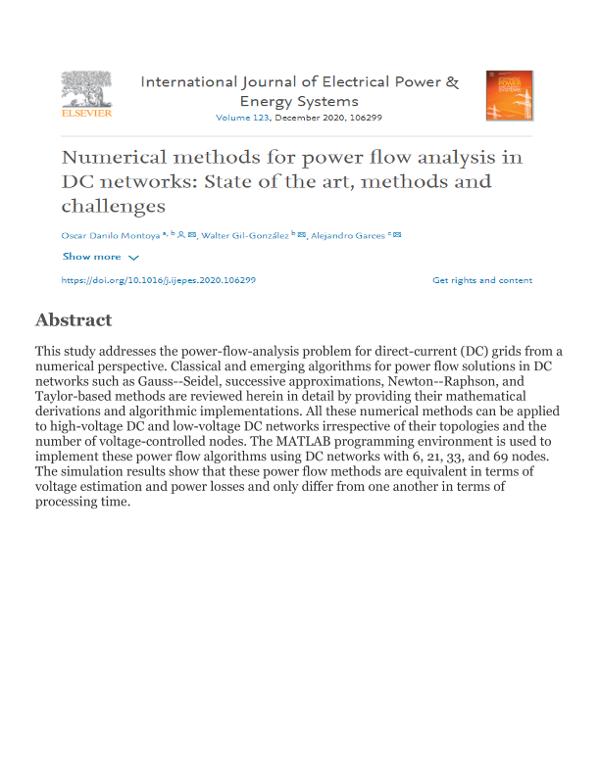Mostrar el registro sencillo del ítem
Numerical methods for power flow analysis in DC networks: State of the art, methods and challenges
| dc.contributor.author | Montoya, Oscar Danilo | |
| dc.contributor.author | Gil-González, Walter | |
| dc.contributor.author | Garcés, Alejandro | |
| dc.date.accessioned | 2020-10-30T15:44:32Z | |
| dc.date.available | 2020-10-30T15:44:32Z | |
| dc.date.issued | 2020-12 | |
| dc.date.submitted | 2020-10-29 | |
| dc.identifier.citation | Montoya, O., Gil-González, W. and Garces, A., 2020. Numerical methods for power flow analysis in DC networks: State of the art, methods and challenges. International Journal of Electrical Power & Energy Systems, 123, p.106299. | spa |
| dc.identifier.issn | 0142-0615 | |
| dc.identifier.uri | https://hdl.handle.net/20.500.12585/9510 | |
| dc.description.abstract | This study addresses the power-flow-analysis problem for direct-current (DC) grids from a numerical perspective. Classical and emerging algorithms for power flow solutions in DC networks such as Gauss--Seidel, successive approximations, Newton--Raphson, and Taylor-based methods are reviewed herein in detail by providing their mathematical derivations and algorithmic implementations. All these numerical methods can be applied to high-voltage DC and low-voltage DC networks irrespective of their topologies and the number of voltage-controlled nodes. The MATLAB programming environment is used to implement these power flow algorithms using DC networks with 6, 21, 33, and 69 nodes. The simulation results show that these power flow methods are equivalent in terms of voltage estimation and power losses and only differ from one another in terms of processing time. | spa |
| dc.description.tableofcontents | 1. Introduction 2. Mathematical formulation 3. Numerical methods for power flow analysis 4. Test systems 5. Numerical results 6. Conclusions and future works Declaration of Competing Interest References | spa |
| dc.format.mimetype | application/pdf | spa |
| dc.language.iso | eng | spa |
| dc.source | International Journal of Electrical Power & Energy Systems; Vol. 123, (2020) | spa |
| dc.title | Numerical methods for power flow analysis in DC networks: State of the art, methods and challenges | spa |
| datacite.rights | http://purl.org/coar/access_right/c_14cb | spa |
| oaire.version | http://purl.org/coar/version/c_970fb48d4fbd8a85 | spa |
| dc.identifier.url | https://www.sciencedirect.com/science/article/abs/pii/S014206151933577X | |
| dc.type.driver | info:eu-repo/semantics/article | spa |
| dc.type.hasversion | info:eu-repo/semantics/publishedVersion | spa |
| dc.identifier.doi | 10.1016/j.ijepes.2020.106299 | |
| dc.subject.keywords | High Voltage Direct Current System | spa |
| dc.subject.keywords | Offshore Wind Farms | spa |
| dc.subject.keywords | Circuit Breakers | spa |
| dc.rights.accessrights | info:eu-repo/semantics/closedAccess | spa |
| dc.identifier.instname | Universidad Tecnológica de Bolívar | spa |
| dc.identifier.reponame | Repositorio Universidad Tecnológica de Bolívar | spa |
| dc.publisher.place | Cartagena de Indias | spa |
| dc.type.spa | Artículo | spa |
| dc.audience | Investigadores | spa |
| oaire.resourcetype | http://purl.org/coar/resource_type/c_dcae04bc | spa |
Ficheros en el ítem
Este ítem aparece en la(s) siguiente(s) colección(ones)
-
Productos de investigación [1453]
Universidad Tecnológica de Bolívar - 2017 Institución de Educación Superior sujeta a inspección y vigilancia por el Ministerio de Educación Nacional. Resolución No 961 del 26 de octubre de 1970 a través de la cual la Gobernación de Bolívar otorga la Personería Jurídica a la Universidad Tecnológica de Bolívar.












